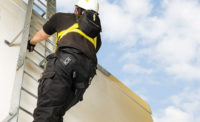In most cases, layering includes a base layer garment, a middle layer and an outer shell. While each layer plays an important role in protecting the wearer, the critical foundation of the clothing system is the layer closest to the skin. This base layer must be comfortable, dry quickly, and efficiently wick moisture, even when worn in extreme conditions.
A good base
Although personal protective equipment (PPE) in many splash-metal environments, such as smelters and foundries, is layered, historically there has been little or no attention paid to the importance of a base layer. Workers have typically worn a cotton T-shirt and briefs, a comfortable and inexpensive combination but one that has serious drawbacks. The cotton absorbs moisture and holds it close to the skin. A cotton base layer also provides virtually no additional protection in the event of an accident or other unforeseen circumstance.While there are lessons to be learned from the outdoor apparel industry that can be applied to industrial safety clothing, the base layer solutions advocated by the outdoor industry, which include versions of polypropylene or other synthetic micro-fibers, are not appropriate in the high-heat environment of a smelter or foundry. Long underwear made of meta-aramids, essentially high-temperature plastics, is also not suitable where there is risk of exposure to molten metals. This type of clothing can also be uncomfortable due to its limited moisture wicking capacity.
Fortunately, a new generation of carbon-based materials have been developed that can be incorporated into the base layer of a multi-layered PPE ensemble.
Reduction in burns
Nucor Steel began offering fire-resistant (FR) long underwear made from a proprietary carbon-based material [CarbonX non-flammable fabric from Chapman Innovations] as an optional component in its PPE program almost two years ago. Since then the company has seen a dramatic reduction in burns from molten metals, particularly in its melt shops and galvanizing lines. Workers’ coveralls take the brunt of exposure to high heat and splash metal, but when molten metal penetrates the primary layer, the base layer garment, made of blended carbon fibers that are highly resistant to molten metal, prevents the hot metal from touching the skin. The presence of the base layer provides an important additional line of defense from the neck to the ankles.In addition to aiding in the prevention of nuisance burns, an appropriate base layer garment can significantly reduce serious injuries and even death in the event of an accident. The following excerpt is from an email sent to a textile manufacturer that provides the material for the FR long underwear.
“On February 2, 2004, my husband, who works in a steel mill, was on a bobcat pushing hot slag. When hot met cold, molten slag exploded all over his body. The steel melted the safety belt preventing him from freeing himself. He was wearing the normal steel mill greens, but he had also worn his carbon-based underwear that night due to the cold weather. His greens were almost completely burned off his body. The carbon-based hood and long underwear he was wearing saved his life.â€
Note: This email was edited to improve readability, but the original intent of the message was preserved.
Although incidents of this nature are increasingly rare, they do occur. In this instance, the availability of an FR base layer garment and the worker’s decision to wear it saved his life. He actually returned to full-time work a few months later.





